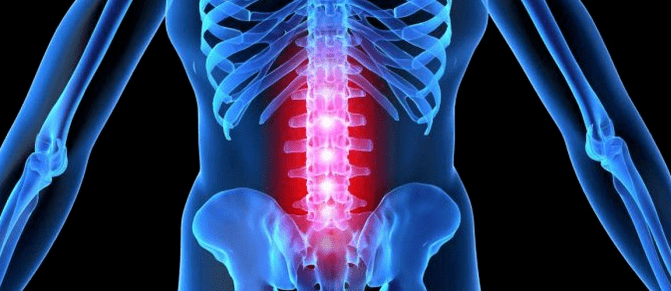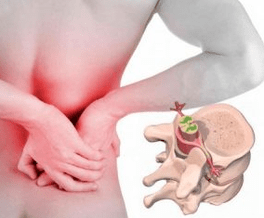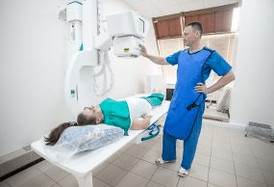A degenerative disease in which the vertebrae body is destroyed and the intervertebral disc is deformed is called lumbar spine osteochondrosis.The causes of such pathology can be diverse and, to be treated correctly, it is important to determine what exactly affected the progression of deformation in the lower back.If a person is concerned about the characteristic symptoms of osteochondrosis, you need to contact the hospital immediately.
In 1 stage, it will be possible to cure the problem with special medications and exercises, but the conservative method does not always help 2-3 degrees, so you need to resort to a surgical treatment method.

The main reasons
Lumbar osteochondrosis on the left or right side is a degenerative disease in which the intervertebral disc is destroyed, a fibrous ring breaks and a person has a hernia that causes acute pain and impaired functioning of the musculoskeletal system.The following factors can cause osteochondrosis in the lower back:
- Increased physical activity in the lower spine;
- Incorrect location of the body when walking, sitting;
- Sedentary and sedentary lifestyle;
- impaired posture;
- lesions, fractures or bruises that cause degenerative consequences in the spine;
- Congenital pathologies of the structure of the musculoskeletal system, in which signs of deformation can already be seen in the child;
- obesity;
- Stress, malnutrition.
Stages and symptoms
Signs of lumbar osteochondrosis develop as the disease progresses, and the higher the stage, the stronger the symptom manifests itself.There are 4 degrees in total:
- At 1 stage, the fibrous ring is damaged, the pain is not pronounced and usually bothers you after a prolonged walk.The pain manifests itself by 2 species - lumbalgia, when the symptom is constantly bothered, and lumbago, in which the signs occur suddenly.
- Pop 2 degrees osteochondrosis is characterized by a great destruction of the fibrous ring and disk dystrophy.This violation leads to a decrease in space between the vertebrae and the tightening of the nerve fibers.The progressive stage of 2 is accompanied by severe low back pain, in the morning there is a stiffness that does not go through a long time.
- In three steps, the fibrous ring in the affected area is completely destroyed, which is why a hernia is formed that compresses the vessels and roots of the spinal nerves.The back hurts constantly, the symptoms do not withdraw after rest and reduction of cargo, you feel tingling and weight on your legs.In the third degree, the dystrophy of muscle fibers occurs as a result of which the patient's movements are limited.
- In 4 steps, the spine is completely deformed, a person is concerned with acute pain, because motor activity is completely limited.Due to impaired innervation and blood supply, the swelling in the legs appears, bone formations grow between the vertebrae.In the last extension, the risk of disability is high.
Osteochondrosis syndromes of the lumbar spine
Lumbar osteochondrosis is manifested by the following syndromes:
- Pain.This is the main symptom that characterizes degenerative-distribution disorders in the spine.As pathology advances, symptoms are pronounced, attacks can last several days, negatively affecting human health.
- KORESHKA.Due to the damage of the damaged body, the height of the intervertebral space decreases, due to which vertebrae become unstable, irritating and squeezed in nerve endings.A person is concerned with acute pain, inflammation of the nerves, impaired blood supply.The muscle structure is atrophied, because the functionality of the lower ends is disturbed.
- Ischemic.Progressive osteochondrosis of the lumbar region leads to the fact that the vessels and blood arteries that pierce the spine begin to compress.This interrupts the blood supply and the nutrition of internal organs and tissues and also causes acute pain within the thighs in the perineum.If the problem is not eliminated in a timely manner, paralysis or paresis is possible.
- Vertebrate.With the progression of pain, ischemic and root syndromes, the patient's column is gradually deformed, which significantly affects the condition and the good -to be.The muscles become weak, the march changes, the person tries to distribute the load in the spine, so that when moving to experience a minimum of discomfort.Such violations affect the work of internal organs, while intervertebral discs continue to deform and be damaged even more.

If the treatment of lumbar osteochondrosis has been inappropriate or performed in a timely manner, dangerous complications may develop.In women, when vertebrae at L1 - S1 levels, complications can occur during pregnancy, especially in the last periods, when the load in the spine spine is maximum.In men, degenerative processes in the lower back often cause power problems.Premature treatment threatens reactive spondylosis as well as a high probability of developing knee osteoarthritis, hip joint.Other consequences also manifest themselves:
- Vascular compression ischemia;
- protrusion;
- spondylartrosis;
- paresis.
Diagnosis
For the doctor to choose effective treatment methods, he needs to establish a precise diagnosis.The diagnosis begins in the office of a neuropathologist, who conducts an initial examination, palpate the affected area, evaluates the nature of changes in the spine.In the acute period, the patient can hardly move and perform complex manipulations.For a more detailed study of the spine column, the instrumental diagnosis is prescribed, which includes:
- X -Ray.It is carried out in 3 projections, the images show the degree of pathology progression, the size of the intervertebral slit, saline deposits, the structure of the vertebrae.
- CT or magnetic resonance imaging.Give a more detailed image of the state of the spine and the discs, show soft tissue violations, which cannot be considered during an X -ray examination.
How to treat the problem?
Medicine
The disease is characterized by the progression of a symptom of pain with which not all medications can deal with.In the early stages to interrupt the signals, you can take painkillers.And also the problem is treated using special ointments and gels.In advanced cases, these drugs will be ineffective, so the doctor will prescribe injections, thanks to the relief of pain and first aid will be opportune.

Non -esteroid anti -inflammatory drugs help relieve swelling and inflammation, so that nerve fibers and blood vessels interrupt compaction and pain symptoms decrease.The group includes funds:
- Painkillers.With the progression of the acute period, when the pains are severely expressed, the medicines of this group are prescribed.As they have side effects, do not buy funds at their discretion.A safe and effective medicine should be prescribed by a doctor.
- Muslaxantes.Relieving muscle cramps because pain and discomfort are reduced.
- Glicosteroids.Eliminate inflammation, positively affect the nervous system, improve the patient's condition in a short time.
Exercises
If osteochondrosis L5 - S1 is diagnosed or discs at L3 level - S1 are affected, therapeutic exercises are required.When performing the training complex, it is important to increase the load gradually so that there is no discomfort and pain.It is recommended to do the following exercises with osteochondrosis:
- In standing position, make curves to the right and left, leaning against and backwards.
- Standing on all fours, folds and align the back.
- Lying on the floor, lifting to the legs, without tearing the lower back from the floor.
- In the position lying with the left hand, reach the limb, located right and, inversely.
Massage and Physiotherapy
Chronic osteochondrosis at the remission stage is successfully treated using massage procedures performed by a manual therapist.Massage will help normalize blood circulation in the affected area, to establish nutrition.Physiotherapeutic procedures have a similar effect:
- electrophoresis;
- Therapy with Magnetot;
- laser therapy;
- Uhf.
If patients with left or right osteochondrosis have not helped conservative methods, you will not be able to do no surgical treatment.Microdysctomy is often used, in which the horny hernia is removed using microcurgical tools.Psidium's minimum procedure the next day after surgery, the patient may begin to move.
Prevention
As adults and children suffer from osteochondrosis, it is important even from an early age monitor the spine, control posture, pay attention to the appearance of flexion or movement.If there is a suspected deformation, you should consult a doctor.The sooner the disease is diagnosed, the easier it will be to fight later.





































